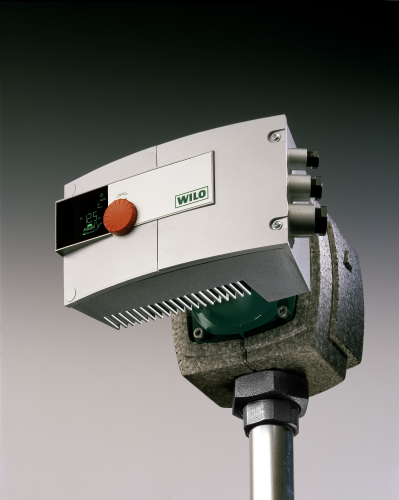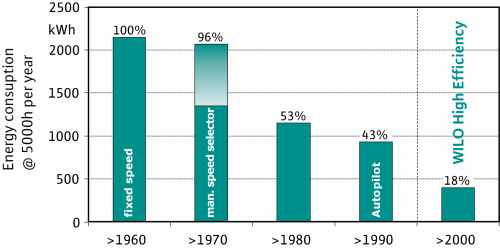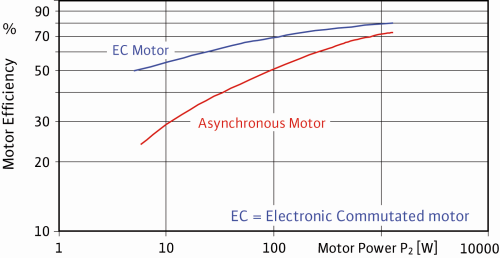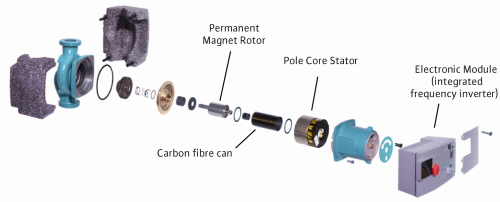



Today, there are 87 million circulators (250 W or less) installed in the European Union consuming approximately 40,000 kW of electrical energy. For a single average household the electrical consumption of a circulator accounts for up to 15% of the total electricity used. Recently, new products based on new motor concepts with permanent magnet rotor technology offer the potential to reduce energy consumption by up to 80% compared to standard circulators.
A history of development
As technology has advanced over the past few years, many efforts have been made to optimise pump technology. In the 1960s a circulator of around 180 W consumed on average 2,200 kWh. The introduction of the manual speed selector allowed users to adjust their equipment to the real needs of the heating system in real time, reducing energy consumption.
During the 1980s the motor technology improved further. The introduction of electronics into the pump opened up new possibilities. With integrated power electronics, the adjustment of the motor speed based on control operation, like constant or variable differential pressure, had an enormous effect on the power consumption.
Efficiency was further improved with the night control function, a self-monitoring system that kicks in when the heating system is in night-mode. Nevertheless, at that point in time nearly all technical options to improve efficiencies on asynchronous motor circulators had been tried. In order to move this mature technology forward, new approaches were needed.
Technology advancement
The advantage of a typical wet runner motor is normally linked with a relatively low efficiency compared to other pump types. A quantum leap in efficient took place when the ECM (electronically commutated motor) was introduced. With this technology, which utilises a permanent magnet rotor in circulators, it was possible to double the efficiency of wet runner motors. Products with lower power have disproportionately high energy saving potentials. ECM's are different from traditional asynchronous motor pumps in the following ways:
- Higher motor speeds are possible, and speeds up to 4,800 rpm have been realised.
- Higher motor efficiencies up to 82% are feasible and therefore so are considerably higher total pump efficiencies. The maximum efficiency is important, but so is the fact that the efficiency stays high over a wide area of flow in part-load conditions.
- The ECMs have up to four times higher starting torque.
- Smaller pump dimensions due to the higher motor speed can be realised if motors with the same power rate are compared.
- A lower pump weight can be achieved. This can be a distinct advantage when raw materials like copper and steel are expensive.
In addition to the benefits mentioned above, high efficiency circulators have the same advantages as other speed controlled pumps. Pump manufacturers investing in this new motor technology had to answer difficult questions about production, and were also facing other challenges. They had many years of experience with asynchronous wet runner pumps - what would the long-term stability of these new motors be? There were also questions about the noise behaviour of the products inside the systems and their resistance against dirt. Heating circulators often have a life time of more than 10 years, so the answers to these questions had long-term consequences. Market feedback, field return analyses and long-term laboratory tests all confirmed the suitability of the technology. More and more high efficiency pumps achieved the breakthrough in substituting standard circulators.
Customer advantages
Of course the economical and ecological impact of the energy consumption of pumps is in the focus in the EU for a longer period of time. The life cycle cost of equipment is usually used to compare products and to see the effect of the cost of energy, although these data are not used very often to compare products in the building services business. Instead, an easier classification system for circulators was developed.
Measurements showed that, de-pending on the operation over the year, the load of a heating circulator differs, and that most of the time the circulator runs at partial load. Based on this survey, a common load profile (as already used for the German energy label "Blauer Engel" for circulators) was agreed upon and integrated into a standard EU energy label. This A to G label as it is used for household lamps is valid for all circulators in residential and commercial systems (Figure 5). The labels are calibrated so that most of the non-controlled circulators on the market today will get a "D" or "E" label, whereas high efficiency pumps (speed controlled circulators with a permanent magnet rotor) will get an "A" label.
This labelling scheme can be used as an easy indication for the end-users or customers who are normally not involved in the purchasing process of these products.
Heating systems aren't the only target applications. Because the Wilo-Stratos product range is able to work in hot and cold applications (with a fluid temperature range of -10°C to +110°C), it can be used in sanitary hot water systems, chillers, heat pumps, solar systems, etc, a huge energy saving potential outside of the classical heating market.
Studies of the International Energy Agency (IEA) investigating energy consumption in Europe show that small circulators will consume about 43,000 GWh of electrical energy in 2030 if we continue with current technology. The pump segment represents one of the largest energy saving potentials within the electrical household appliances. By switching to the High Efficiency Pump Technology this energy consumption could be reduced dramatically.





